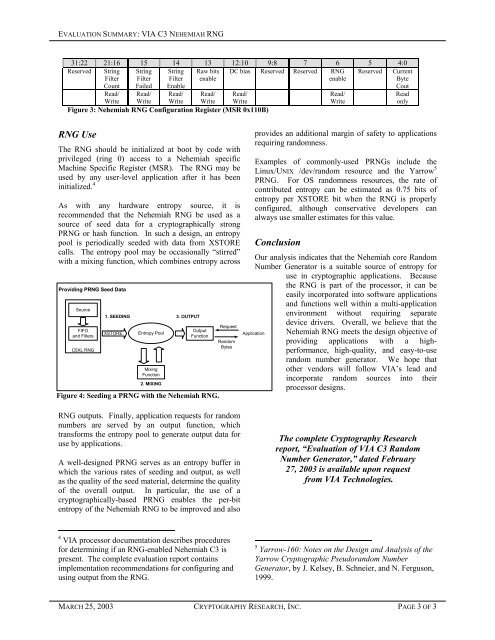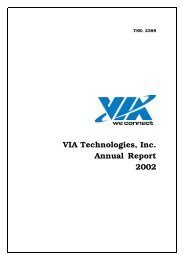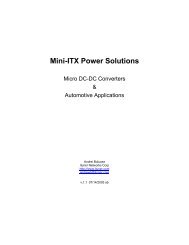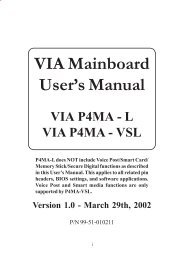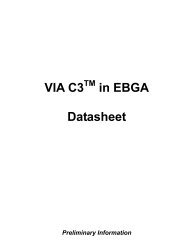via c3 nehemiah random number generator - VIA Technologies, Inc.
via c3 nehemiah random number generator - VIA Technologies, Inc.
via c3 nehemiah random number generator - VIA Technologies, Inc.
You also want an ePaper? Increase the reach of your titles
YUMPU automatically turns print PDFs into web optimized ePapers that Google loves.
EVALUATION SUMMARY: <strong>VIA</strong> C3 NEHEMIAH RNG<br />
31:22 21:16 15 14 13 12:10 9:8 7 6 5 4:0<br />
Reserved String<br />
Filter<br />
Count<br />
Read/<br />
Write<br />
RNG Use<br />
The RNG should be initialized at boot by code with<br />
privileged (ring 0) access to a Nehemiah specific<br />
Machine Specific Register (MSR). The RNG may be<br />
used by any user-level application after it has been<br />
initialized. 4<br />
As with any hardware entropy source, it is<br />
recommended that the Nehemiah RNG be used as a<br />
source of seed data for a cryptographically strong<br />
PRNG or hash function. In such a design, an entropy<br />
pool is periodically seeded with data from XSTORE<br />
calls. The entropy pool may be occasionally “stirred”<br />
with a mixing function, which combines entropy across<br />
Providing PRNG Seed Data<br />
Source<br />
FIFO<br />
and Filters<br />
C5XL RNG<br />
1. SEEDING<br />
XSTORE<br />
String<br />
Filter<br />
Failed<br />
Read/<br />
Write<br />
Entropy Pool<br />
Mixing<br />
Function<br />
2. MIXING<br />
String<br />
Filter<br />
Enable<br />
Read/<br />
Write<br />
3. OUTPUT<br />
Raw bits<br />
enable<br />
Read/ Read/<br />
Write Write<br />
Figure 3: Nehemiah RNG Configuration Register (MSR 0x110B)<br />
Output<br />
Function<br />
Figure 4: Seeding a PRNG with the Nehemiah RNG.<br />
Request<br />
Random<br />
Bytes<br />
RNG outputs. Finally, application requests for <strong>random</strong><br />
<strong>number</strong>s are served by an output function, which<br />
transforms the entropy pool to generate output data for<br />
use by applications.<br />
A well-designed PRNG serves as an entropy buffer in<br />
which the various rates of seeding and output, as well<br />
as the quality of the seed material, determine the quality<br />
of the overall output. In particular, the use of a<br />
cryptographically-based PRNG enables the per-bit<br />
entropy of the Nehemiah RNG to be improved and also<br />
4 <strong>VIA</strong> processor documentation describes procedures<br />
for determining if an RNG-enabled Nehemiah C3 is<br />
present. The complete evaluation report contains<br />
implementation recommendations for configuring and<br />
using output from the RNG.<br />
DC bias Reserved Reserved RNG<br />
enable<br />
provides an additional margin of safety to applications<br />
requiring <strong>random</strong>ness.<br />
Examples of commonly-used PRNGs include the<br />
Linux/UNIX /dev/<strong>random</strong> resource and the Yarrow 5<br />
PRNG. For OS <strong>random</strong>ness resources, the rate of<br />
contributed entropy can be estimated as 0.75 bits of<br />
entropy per XSTORE bit when the RNG is properly<br />
configured, although conservative developers can<br />
always use smaller estimates for this value.<br />
Conclusion<br />
Our analysis indicates that the Nehemiah core Random<br />
Number Generator is a suitable source of entropy for<br />
use in cryptographic applications. Because<br />
the RNG is part of the processor, it can be<br />
easily incorporated into software applications<br />
and functions well within a multi-application<br />
environment without requiring separate<br />
device drivers. Overall, we believe that the<br />
Nehemiah RNG meets the design objective of<br />
providing applications with a highperformance,<br />
high-quality, and easy-to-use<br />
<strong>random</strong> <strong>number</strong> <strong>generator</strong>. We hope that<br />
other vendors will follow <strong>VIA</strong>’s lead and<br />
incorporate <strong>random</strong> sources into their<br />
processor designs.<br />
Application<br />
Reserved Current<br />
Byte<br />
Cout<br />
Read<br />
only<br />
5 Yarrow-160: Notes on the Design and Analysis of the<br />
Yarrow Cryptographic Pseudo<strong>random</strong> Number<br />
Generator, by J. Kelsey, B. Schneier, and N. Ferguson,<br />
1999.<br />
MARCH 25, 2003 CRYPTOGRAPHY RESEARCH, INC. PAGE 3 OF 3<br />
Read/<br />
Write<br />
The complete Cryptography Research<br />
report, “Evaluation of <strong>VIA</strong> C3 Random<br />
Number Generator,” dated February<br />
27, 2003 is available upon request<br />
from <strong>VIA</strong> <strong>Technologies</strong>.


